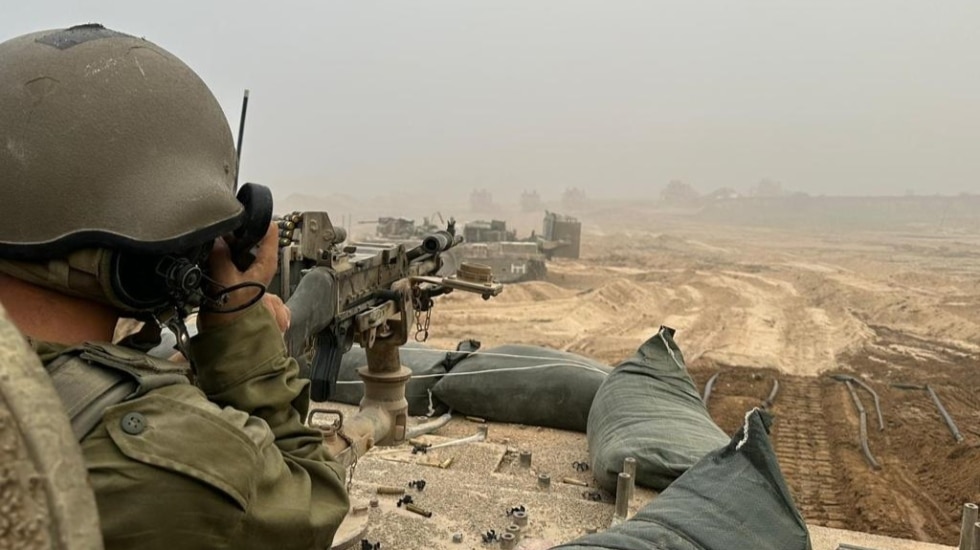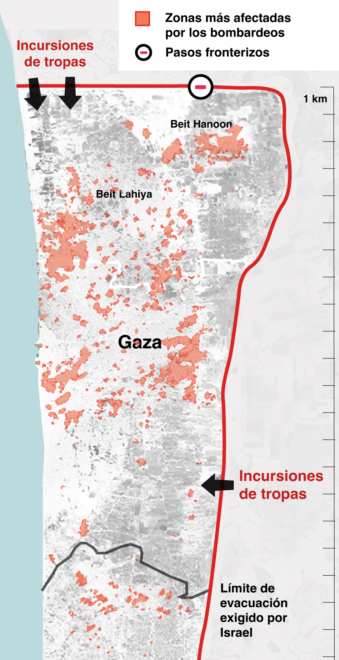

Israeli army in the Gaza Strip
Alexander the Great’s troops and Napoleon’s soldiers passed through Salah al-Din, the main artery and oldest road crossing Gaza from north to south. Several Israeli tanks and an excavator arrived along this route this Monday in the Israel Defense Forces’ (IDF) closest incursion so far into the capital of the Gaza Strip. Over the weekend, Israel entered what it called the “second phase” of its war against Hamas, a euphemism to avoid mention of a ground offensive. In any case, this is not yet a large-scale invasion.
Israeli Prime Minister Benjamin Netanyahu said the Israeli military has “expanded land access to the Gaza Strip and is doing so in measured and very powerful steps.” Netanyahu added that this is a “methodical” advance in which Tzahal is taking it step by step.”
The military is talking about a “gradual” deployment. They are going to gradually have reserves in case of need to act against Hezbollah and not to spread the idea of an “invasion” that could provoke an escalation in southern Lebanon.
It is the Israeli army’s most important operation in decades and was preceded by an unprecedented mobilization of reservists: some 360,000 were called up and joined the regular forces, some 170,000 troops.
“We won’t know when one thing will end and another will begin, because they are not interested in it. We are closer to exploring and investigating Hamas’s defensive posture than to a large-scale invasion. First, an intelligence operation is needed to select targets and start with the most accessible, as happened in 2014,” says Felix Arteaga, senior researcher at the Royal Elcano Institute.

Army spokesman Daniel Hagari, while not acknowledging the presence of tanks at the Netzarim checkpoint, confirmed that our force activity “has been expanded and additional troops have entered the sector, including infantry, armored vehicles, engineering corps and artillery.” In turn, he acknowledged that there had been “direct fighting” between Israeli forces and Hamas militants in the Gaza Strip.
Intense air campaign
These actions are accompanied by intense bombing. The attacks, which were largely concentrated around the capital, killed more than 8,300 Palestinians but were also reported in the south, where Gazans would theoretically have sought refuge to be safer.
“The first thing we saw was a very intense air campaign, still ongoing, targeting High Value Venues (HVTs) previously identified by intelligence. These targets will house Hamas facilities, personnel or command and control systems,” says Francisco Gan. Pampols, reserve lieutenant general.
“We have also witnessed the isolation of the entire coastal zone, which corresponds to the western façade of the sector in the Mediterranean area. The Israeli Navy blocked it. They hit targets there from naval platforms, especially frigates,” adds Gan Pampols. After the first incursions, the end was “isolation of the northern part of the sector with calls for evacuation.”
Israel declared a state of war against Hamas following the October 7 massacre. What Shabbat Black first fired thousands of rockets at various locations in Israel and then carried out an invasion by approximately 2,000 terrorists that killed at least 1,400 Israelis, including civilians and soldiers.
Most of the civilians lived in kibbutzim located in southern Israel, near the Gaza Strip, where Hamas spread terror: killing, raping, robbing and kidnapping Israeli citizens and foreigners. According to the latest balance sheet, there are 239 hostages in his hands, ranging in age from nine months to 85 years. So far, only four people have been released: two octogenarian women, a mother and her daughter living in Chicago. One of the captives is the Spaniard Ivan Illarramendi, who lived in Kibbutz Kissufim.
Dozens of terrorists killed
Israeli troops spotted an anti-tank missile launch site near Al-Azhar University, south of Gaza City, and sent a fighter jet to destroy it. It was one of 600 targets they hit on Sunday. The Israeli military also shot down several Hamas militants emerging from a tunnel near the Erez Pass. According to Israel, Hamas has not yet put up much resistance. But his territory is urban battles.
“Once they were identified, they attacked the terrorists and killed them,” a military spokesman said, citing dozens killed. He did not provide details about current operations. It is known that the raids began in Beit Hanoun in the north of the sector and Bureij in the center. In the north, Israeli soldiers raised a flag outside a beach hotel.
According to Gan Pampols, “There will be no forceful invasion or tanks in Gaza City. They have not entered the densely populated urban centers. The tanks are in Beit Hanoun, where they act as siege troops.” We are at this stage.
Next steps
After the dimensions of the fence are established, it will be divided into quarters and blocks. A neutralization operation will be carried out in these areas. “First they will look for Hamas’ command and control systems, their logistics warehouses, access to the tunnel network and try to build a map. They will have to see if they are blinded, destroyed, or fighting inside. The decision will depend on whether they believe there are hostages inside,” says the reserve lieutenant general. Just this Monday, Hamas released another video of three hostages asking the Israeli government to do whatever is necessary to free them. Netanyahu called it “cruel propaganda”.
“We won’t see too much action, and it won’t be on a large scale… We will be looking to secure area by area, and at the same time there will be reconnaissance operations.”
Francisco Gan Pampols, reserve lieutenant general
According to Gan Pampols, “we will not see too many actions and they will not be large-scale. It will be a combination of mechanized and lightly armored units, there will be sappers, direct fire support from tanks and accompanying artillery, a large deployment of surveillance and information acquisition equipment, UAVs, electronic warfare… “There will be clearing and guarding area by area. First one area, then the neighboring one. At the same time, reconnaissance operations will be carried out to locate the hostages and eliminate the leaders. And also dismantle the tunnel network.” -soldier, provided a lot of information about her captors.
Israel’s armed forces have a clear superiority over Hamas, but that does not mean they have won the war. The raid they carried out on October 7 was unimaginable, but it happened. There were failures in intelligence (Shin Bet) and in the Armed Forces, which took seven to eight hours to reach the kibbutz. But the most ultranationalist government in Israeli history has long been more concentrated in the West Bank than in the Gaza Strip.
Moreover, after the coup d’etat Shabbat Black, the Israeli army must minimize its losses, take into account that Hamas has 239 hostages, and reduce the number of civilian casualties, which is now frightening. More children have died in Gaza than in all conflicts since 2019. Nearly half of the more than 8,300 Palestinian victims of Israeli bombing are children.
“The confrontation is asymmetrical, and the more civilian and Israeli casualties there are, the better for Hamas.”
Felix Arteaga, Elcano explorer
“This will be a long war. In Mosul it lasted nine months. The confrontation is asymmetrical, and the more civilian casualties and the more Israeli casualties, the better it will be for Hamas. “They influence international support. This asymmetry will make the war very difficult for Israel. Military superiority is largely due to this asymmetry,” concludes Felix Arteaga.
It is unclear how much time Israel has to achieve its goals. The humanitarian catastrophe in Gaza due to the trickle of aid, thousands of casualties, and the threat to hospitals that cannot be evacuated are damaging the image of the Israeli government, which is increasingly being questioned. Abroad, Israel is losing the battle of public opinion. And the war has barely begun.
Source: El Independiente